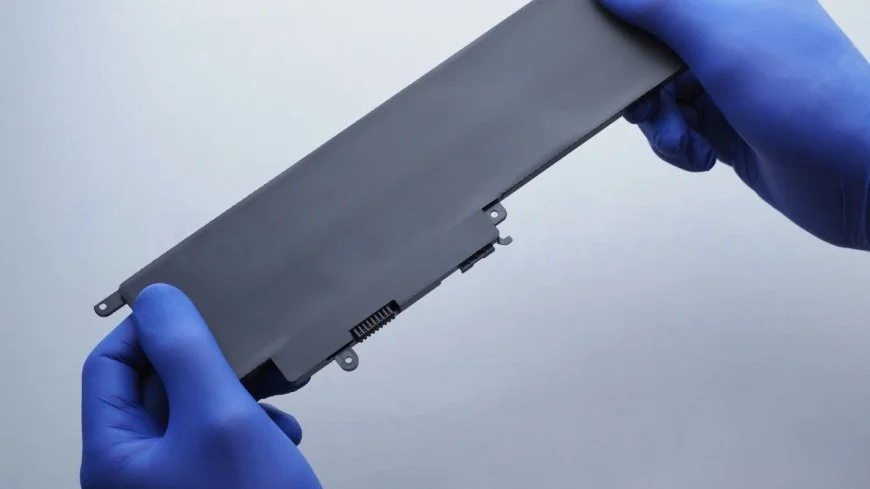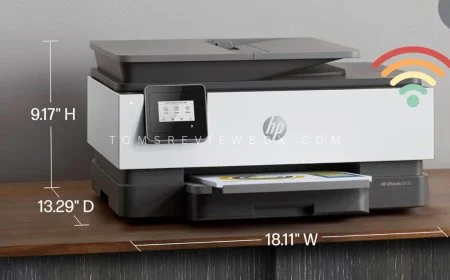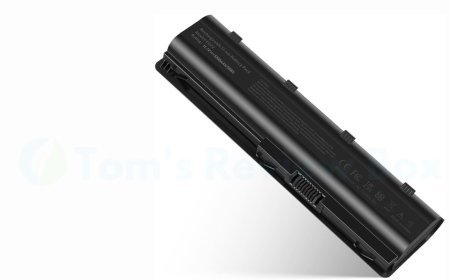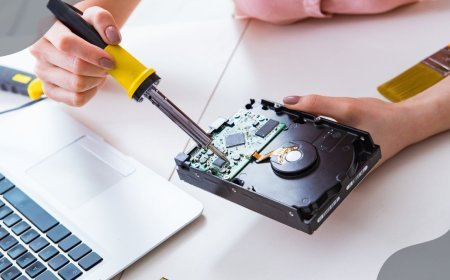How to Take Out Laptop Battery: Step-by-Step Guide
iscover the step-by-step guide on how to take out your laptop battery. Learn the proper technique to safely remove and replace it.

Ever wondered how to take out a laptop battery effortlessly, especially on modern laptops with a lock switch? What if I told you there's a simple way to do it without any hassle? In this guide, we'll walk you through the steps to safely remove your laptop battery, ensuring smooth operation and longevity for your device.
Key Takeaways
-
Understand your laptop battery: Learn about the type of battery your laptop uses and its characteristics to make informed decisions.
-
Identify defective batteries in laptops: Recognize signs of a failing battery such as reduced capacity or overheating to prevent damage to your laptop.
-
Remove the battery safely: Follow proper procedures to take out the laptop battery without causing harm to yourself or the device, reattach the back panel and screws carefully to the motherboard.
-
Choose the right battery wisely: Select high-quality, compatible batteries to ensure optimal performance and longevity for your laptop.
-
Extend battery life: Implement practices like adjusting power settings and avoiding extreme temperatures to prolong the lifespan of your laptop battery.
-
Operate without a battery if needed: Understand how to use your laptop without a battery when necessary, ensuring uninterrupted work or entertainment.
Understanding Laptop Batteries
Battery Lifespan
Laptop batteries have a limited lifespan, typically measured by the number of charge cycles they undergo. This varies depending on usage patterns and how they are charged. Factors like temperature and storage conditions also affect how long a battery lasts.
One way to monitor a laptop battery's health is by keeping track of the number of charge cycles it has gone through. Over time, as the battery ages, its capacity to hold a charge diminishes. Charging habits, such as frequently letting the battery drain completely, can also impact its longevity.
Signs of Wear
It's essential to watch out for signs that indicate your laptop battery is wearing out. Physical indications like bulging or overheating are clear signals that the battery may need replacement. Sudden shutdowns or inconsistent power levels can point towards battery wear.
When a laptop battery starts showing signs of wear, it may not hold a charge as effectively as before. Older batteries tend to lose their capacity over time due to repeated charging cycles. If you notice your laptop running out of power quickly or struggling to hold a charge, it might be time for a new battery.
Replacement Indicators
Knowing when to replace your laptop battery is crucial for uninterrupted usage. When the battery no longer holds a charge or if you receive warning messages from the operating system about battery health, it's time for a replacement. Decreased performance and shorter usage times are clear indicators that you need to invest in a new battery.
Recognizing these signs early on can prevent unexpected shutdowns and ensure that your laptop remains functional when you need it most. Keeping an eye on how your laptop battery performs over time can help you plan ahead for replacements before any major issues arise.
Identifying Defective Batteries
Health Checks
Regularly perform health checks using diagnostic tools to assess battery condition. Analyze reports for significant capacity drops and calibrate the battery periodically for accurate readings.
Performance Issues
Address performance issues such as rapid draining or delayed charging. Troubleshoot software-related problems impacting battery performance and optimize power settings for enhanced laptop performance and battery life.
Diagnostic Tools
Utilize built-in Windows tools for detailed battery analysis. Interpret analysis reports to comprehend capacity and charging history, considering third-party software for more comprehensive assessments.
Removing the Laptop Battery
Safety Precautions
Always power off the laptop before removing or replacing the battery to avoid electrical hazards. Handle the battery gently to prevent any damage that could potentially lead to malfunctions. It's crucial to store batteries away from extreme temperatures to maintain their safety and longevity.
Step-by-Step Guide
External Batteries
-
Consider using external batteries for extended power backup during travel or in areas with limited access to charging ports.
-
Enjoy the portability benefits of external batteries, which provide convenient on-the-go charging solutions.
-
Prioritize checking the compatibility of external batteries with your specific laptop model before making a purchase decision.
Built-in Batteries
-
Understand that replacing built-in batteries can be challenging without professional assistance due to their internal positioning.
-
Seek guidance from authorized service centers when dealing with built-in battery replacements for optimal safety and performance.
-
Exercise caution when handling laptops equipped with built-in batteries to prevent accidental damage.
Choosing Replacement Batteries
Original vs Third-Party
When considering replacement batteries, original manufacturer options offer warranty coverage but may be more expensive. Third-party alternatives, while cheaper, might vary in performance. Opt for reputable third-party brands to ensure quality and compatibility.
It's essential to weigh the pros and cons of both types. Original batteries typically come with a warranty, providing assurance of quality. On the other hand, third-party batteries can be more cost-effective but may have varying performance levels.
Ensure you evaluate factors like warranty coverage, performance differences, and overall quality when deciding between original and third-party batteries. Look for reputable third-party brands known for their reliability in the market.
Compatibility Checks
Before purchasing a replacement battery, always verify compatibility with your specific laptop model. Check the voltage and capacity requirements to ensure a proper fit. Using an incompatible battery can lead to damage to your laptop's components.
To avoid damaging your laptop, verify that the replacement battery matches your laptop model precisely. Check for compatibility not only in terms of physical fit but also regarding voltage and capacity specifications.
Cost Considerations
When choosing between self-replacement and professional services, compare the costs involved. Factor in additional expenses such as shipping fees or installation charges. Budget for potential future replacements based on your laptop usage patterns.
Consider the costs associated with replacing the battery yourself versus hiring professional services. Take into account any extra charges like shipping fees or installation costs that might impact your decision-making process.
Installation Process
Inserting New Battery
Insert a new laptop battery following manufacturer's guidelines to ensure proper installation. Securely place the battery in its compartment, checking alignment and connection to avoid issues.
Initial Charging
Fully charge the new battery before first use for optimized performance. Let it complete a full charging cycle to calibrate capacity accurately. Avoid interruptions during this process to prevent calibration errors.
Extending Battery Life
Usage Tips
Implement power-saving strategies by adjusting screen brightness and disabling unused peripherals. Avoid continuous laptop plugging to prevent overcharging. Utilize battery saver modes for critical tasks to extend battery life effectively.
Adopt healthy recharging practices by avoiding frequent partial charges. Aim for full charge cycles to maintain battery health. Disconnect the charger promptly upon reaching full capacity to prevent overcharging.
Operating Without a Battery
Pros and Cons
Laptop batteries provide portability and the freedom to use your device without being tethered to a power outlet. This feature is especially beneficial for individuals who are constantly on the move or work in locations with limited access to power sources.
However, one significant limitation of laptop batteries is their limited lifespan. Over time, batteries degrade, leading to reduced capacity and shorter usage times between charges. This necessitates the need for periodic battery replacements, which can be an additional cost.
When considering whether to operate without a battery, it's essential to weigh the convenience of portability against the hassle of managing battery life and potential replacement costs. Your decision should align with your specific usage requirements and lifestyle.
Power Management
To optimize your laptop's power consumption when operating without a battery, you can adjust various power management settings. By customizing these settings, you can extend your device's battery life by reducing unnecessary energy consumption.
Customizing power plans allows you to strike a balance between performance and energy efficiency based on your needs. For example, you can choose a power plan that prioritizes performance when plugged in but conserves energy when running on battery power.
Monitoring power usage through built-in tools or third-party software helps you identify applications that are draining your laptop's battery unnecessarily. By pinpointing these energy-hungry apps, you can close them or find alternatives that are more energy-efficient.
Troubleshooting Common Issues
Non-Charging Battery
Troubleshoot non-charging issues by checking the power adapter and charging port. Inspect the battery contacts for dirt or damage that may hinder charging. Consider replacing the power adapter if it fails to charge the battery properly.
Rapid Drain Problems
Address rapid battery drain problems by identifying power-hungry applications. Adjust settings to reduce background processes consuming battery power. Monitor battery usage to pinpoint the cause of rapid draining issues.
Enhancing Performance
Software Optimizations
Updating device drivers and the operating system can significantly enhance battery performance. By ensuring that software is up to date, the laptop can work more efficiently, utilizing power at its full capacity. Using battery optimization software helps manage power consumption effectively, prolonging battery life.
Disabling unnecessary startup programs is another crucial step in optimizing battery performance. These programs can drain the battery during laptop boot-up, affecting overall efficiency. By eliminating these unnecessary processes, the laptop can operate more smoothly and sustain power for longer durations.
Hardware Adjustments
Considering hardware upgrades such as increasing RAM can alleviate strain on the battery. More RAM allows the laptop to handle tasks more efficiently, reducing the workload on the battery and enabling it to function closer to its full capacity. This upgrade can lead to improved overall performance and extended battery life.
Regularly cleaning laptop vents and fans is essential in preventing overheating issues that can impact battery performance. Overheating not only affects the laptop's functionality but also accelerates battery degradation. By maintaining proper ventilation, users can ensure that their laptops operate optimally and maintain full capacity power.
Consulting a technician for hardware adjustments is recommended for users seeking to optimize their laptop's battery performance further. Technicians can provide insights into specific hardware tweaks that can improve efficiency and extend full capacity usage of the device. Their expertise can help users make informed decisions regarding upgrades or modifications.
Summary
Understanding how to take out and replace your laptop battery is essential for maintaining the longevity and performance of your device. By identifying defective batteries, safely removing and replacing them, and following best practices for extending battery life, you can ensure smooth operation and optimal efficiency. Troubleshooting common issues and enhancing overall performance will further enhance your laptop experience.
Incorporate these steps into your routine maintenance to keep your laptop running smoothly and efficiently. Remember, a well-maintained battery leads to a longer-lasting laptop. Stay proactive in caring for your device to avoid unexpected downtime or performance issues.
Frequently Asked Questions
How do I identify a defective laptop battery?
To identify a defective laptop battery, look out for these signs:
-
Overheating
-
Short battery life
-
Not holding charge
-
Swollen appearance
-
Laptop shutting down unexpectedly
How can I safely remove my laptop battery?
Follow these steps to safely remove your laptop battery:
-
Power off your laptop.
-
Disconnect the charger.
-
Turn your laptop over.
-
Locate the battery release latch or screws.
-
Slide the latch or unscrew to release the battery.
-
Gently lift out the battery.
What factors should I consider when choosing a replacement laptop battery?
Consider these factors when choosing a replacement laptop battery:
-
Compatibility with your laptop model
-
Battery capacity (mAh)
-
Battery chemistry (e.g., lithium-ion)
-
Brand reputation and reviews
-
Warranty period
Can I operate my laptop without a battery?
Yes, you can operate your laptop without a battery by connecting it directly to a power source using the charger. However, keep in mind that sudden power loss may occur if there is an interruption in the power supply.
How can I troubleshoot common issues related to laptop batteries?
To troubleshoot common issues related to laptop batteries:
-
Check power settings and drivers.
-
Run diagnostics tools provided by the manufacturer.
-
Reset BIOS settings.
-
Update firmware or software.
-
Contact customer support if problems persist.
What's Your Reaction?







































![MacBook Pro M5: All the features and specs you need to know [LEAKS REVEALED]](https://tomsreviewbox.com/uploads/images/202502/image_430x256_67bd6d7cd7562.jpg)



























